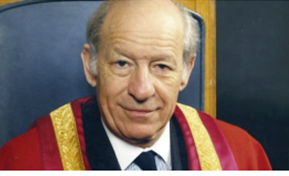Born in October 1927 in Dundee, Michael attended the High School of Dundee until 1944 when he commenced his medical studies in St Andrews, the first in his family to attend university.
Upon graduating, Michael then joined the Royal Army Medical Corps, where he swiftly rose to the rank of Captain and served in Egypt. Here, he ordered his squadron to repaint the barracks before a visit from Countess Mountbatten of Burma, who was apparently so impressed by him that she had him transferred to a cosier billet in Cyprus.
Michael completed his medical training in Bradford, Newcastle and Cleveland, Ohio, before being appointed to a Consultant post in Cardiff in 1961, where he spent the rest of his life. Renowned for keeping the untidiest office in the hospital, colleagues had mentioned how at times it was physically impossible to enter his room due to the mound of paper overflowing from his desk.
What some may say he lacked in height, Michael more than made up for in his attitude towards life with his clear, far-sighted vision coupled with a brisk ‘can-do’ attitude and considerable charm and wit. He was a natural born leader who worked within a medical speciality that, rightly or wrongly, had a reputation for conservatism and timidity. He fought for the recognition of anaesthetists as the guardians of the surgical patient and shunned the image of them being likened to a handmaiden of the surgeon.
The course of his professional career saw his list of achievements continuing to grow. Some of his earliest work in 1960 addressed the issue of a lack of medical suction, something that he tackled so successfully that all in the profession now take effective suction for granted.
Michael was also a pioneer of individualised pain relief after surgery, developing the Cardiff Palliator, a device that allowed patients to trigger delivery of morphine directly into the bloodstream whilst using technology to keep them safe while doing so. He will be primarily remembered, however, as a pioneering obstetric anaesthetist and a champion of maternal safety who published more than 170 papers, and edited and wrote seven books.
In his later years, he focused his attention on achieving standards for pain relief for babies undergoing circumcision. His Jewish faith, although never in the foreground, was a comfort to him. Many of his coreligionists will recall being given a mandatory tumbler of whisky to break their 24-hour Yom Kippur fast.
Family was very much at the heart of Michael’s life. He met his wife Sally at a cocktail party in London and they married several years later in 1955, going on to have three children together, Timothy, Amanda and Mark.
Sally sadly died earlier this year, and Michael, who suffered from Parkinson’s disease, followed her peacefully some two weeks later. He died on May 2 2018, aged 90.
